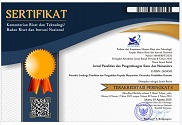Jargon Used by Balinese Traditional Weaving Community
DOI:
https://doi.org/10.23887/jppsh.v5i1.32606Keywords:
Balinese traditional weaving community, Jargons, kamben songket, the meaning of jargons,Abstract
This research was conducted in order to find out the jargons that exist in Balinese traditional weaving community. This research was designed in the form of descriptive qualitative study. The method used in this study were conducting observation and interview. Observation was done in order to observe the condition and jargons used in the weaving process. Meanwhile, interview was done by interviewing three informants and the purpose of the interview was to find out all of the jargons used in this community. The results showed that there were forty-one jargons found in traditional weaving. These jargons were distinguished into three type. Based on the process of producing kambeng songket, there were twelve jargons found. Related to the name of tools and ingredient, there were twenty-three jargons found. Lastly, there were six jargons concerned with naming the motif. All of the jargons have their own meaning used by the weavers in order to communicate each other. This research also helped to document the jargons that exist in Balinese traditional weaving community.
References
Ahmadi, M. R. (2017). The Impact of Motivation on Reading Comprehension. International Journal of Research in English Education, 2(1), 1–7. https://doi.org/10.18869/acadpub.ijree.2.1.1.
Akmajian, A., Farmer, A. K., Bickmore, L., Demers, R. A., & Harnish, R. M. (2017). Linguistics: An introduction to language and communication. MIT Press.
Barber, A. (2010). Concise encyclopedia of philosophy of language and linguistics (R. J. Stainton (ed.)). Elsevier.
Beaulieu, S., Woll, N., French, L. M., & Duchemin, M. (2018). Language learners’ metasociolinguistic reflections: A window into developing sociolinguistic repertoires. System, 76, 210–218. https://doi.org/10.1016/j.system.2018.07.001.
Brown, Z. C., Anicich, E. M., & D. Galinsky, A. (2020). Compensatory conspicuous communication: Low status increases jargon use. Organizational Behavior and Human Decision Processes, 161, 274–290. https://doi.org/10.1016/j.obhdp.2020.07.001.
Eiswirth, M. E. (2020). Increasing interactional accountability in the quantitative analysis of sociolinguistic variation. Journal of Pragmatics, 170, 172–188. https://doi.org/10.1016/j.pragma.2020.08.018.
Heidari, K. (2020). Critical thinking and EFL learners’ performance on textually-explicit, textually-implicit, and script-based reading items. Thinking Skills and Creativity, 37(August), 100703. https://doi.org/10.1016/j.tsc.2020.100703.
Intani, R. (2010). Tenun Gedogan Dermayon. Patanjala : Jurnal Penelitian Sejarah Dan Budaya. Bandung, 2(1), 35–47. https://doi.org/10.30959/patanjala.v2i1.204.
Kurniati, I. (2014). Sociolinguistics analysis of code mixing on Nine Summer Ten Autumns novel by Iwan Setiawan. State Islamic University Syarif Hidayatullah.
Liaw, J., Dani, N., & Johari, A. (2013). Language usage of jargon and slang in strategic studies. Australian Journal of Basic and Applied Sciences, 7(4), 661–666.
Lichtman, M. (2013). Qualitative Research in Education (3rd ed.). SAGE Publications.
Marousek, I. (2015). Analysis of hotel jargon and slang. Masaryk University Brno.
McKee, R., Safar, J., & Alexander, S. P. (2021). Form, frequency and sociolinguistic variation in depicting signs in New Zealand Sign Language. Language and Communication, 79, 79–117. https://doi.org/10.1016/j.langcom.2021.04.003.
Miles, M. B., & Huberman, A. M. (1994). An analytic approach for discovery. CEUR Workshop Proceedings, 89–92.
Onovughe, O. G. (2012). Sociolinguistics inputs and English as second language classrooms. English Language Teaching, 5(8), 157–163. https://doi.org/10.5539/elt.v5n8p157.
Pitana, I. (2010). Tri Hita Karana–the local wisdom of the Balinese in managing development. Trends and Issues in Global Tourism 2010, 139–150.
Roth, D., & Sedana, G. (2015). Reframing Tri Hita Karana: From ‘Balinese Culture’to Politics. The Asia Pacific Journal of Anthropology, 16(2), 157–175. https://doi.org/10.1080/14442213.2014.994674.
Seken, K. (2017). Introduction to linguistics. RajaGrafindo Persada.
Sevy-Biloon, J. (2018). Integrating EFL Skills for Authentically Teaching Specific Grammar and Vocabulary. Studies in English Language and Education, 5(2), 175–184.
Sugiyono. (2017). Metode Penelitian Kualitatif. Bandung: Alfabeta.
Thomas, M., Hariharan, M., Rana, S., Swain, S., & Andrew, A. (2014). Medical jargons as hindrance in doctor–patient communication. Psychological Studies, 59(4), 394–400. https://doi.org/10.1007/s12646-014-0262-x.
Wardhaugh, R. (2006). An Introduction to Sociolinguistics. In Blackwell Textbooks in Linguistics. Blackwell Publishing Ltd. https://doi.org/10.1353/lan.2003.0268.
Weizheng, Z. (2019). Teacher-Student Interaction in EFL Classroom in China: Communication Accommodation Theory Perspective. English Language Teaching, 12(12), 99. https://doi.org/10.5539/elt.v12n12p99.
Downloads
Published
Issue
Section
License
Authors who publish with the Jurnal Penelitian dan Pengembangan Sains dan Humaniora agree to the following terms:
- Authors retain copyright and grant the journal the right of first publication with the work simultaneously licensed under a Creative Commons Attribution License (CC BY-SA 4.0) that allows others to share the work with an acknowledgment of the work's authorship and initial publication in this journal.
- Authors are able to enter into separate, additional contractual arrangements for the non-exclusive distribution of the journal's published version of the work (e.g., post it to an institutional repository or publish it in a book), with an acknowledgment of its initial publication in this journal.
- Authors are permitted and encouraged to post their work online (e.g., in institutional repositories or on their website) prior to and during the submission process, as it can lead to productive exchanges, as well as earlier and greater citation of published work. (See The Effect of Open Access)










